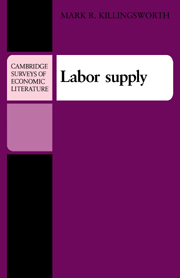Book contents
- Frontmatter
- Contents
- List of tables and figures
- Preface
- 1 The simple static model of labor supply
- 2 Extensions of the simple short-run model of labor supply
- 3 Empirical studies of static labor supply models: introduction, with a summary of “first-generation” results
- 4 Second-generation studies of static labor supply models: methodology and empirical results
- 5 Dynamic labor supply models
- 6 Labor supply, taxes, and transfers
- 7 Conclusion
- Bibliography
- Name index
- Subject index
1 - The simple static model of labor supply
Published online by Cambridge University Press: 08 October 2009
- Frontmatter
- Contents
- List of tables and figures
- Preface
- 1 The simple static model of labor supply
- 2 Extensions of the simple short-run model of labor supply
- 3 Empirical studies of static labor supply models: introduction, with a summary of “first-generation” results
- 4 Second-generation studies of static labor supply models: methodology and empirical results
- 5 Dynamic labor supply models
- 6 Labor supply, taxes, and transfers
- 7 Conclusion
- Bibliography
- Name index
- Subject index
Summary
“Economic agents may be taken to reach their decisions in the light of what they want and what they can get” (Arrow and Hahn, 1971, p. 22). Thus, in neoclassical models, labor supply decisions – like consumption decisions, and for that matter all other decisions – are the result of utility maximization (“what agents want”) subject to constraints (“what they can get”).
In the simplest version of the static labor supply model, the individual's utility or well-being depends on his tastes and on the amount of market (i.e., consumer) goods C and hours of leisure time L that he consumes per period. In maximizing utility, the individual faces several constraints. First, the price of a unit of C is P, and the “price” of an hour of L is a fixed amount W, the wage per hour: That is, the individual must forgo or sacrifice W when he devotes an hour to leisure rather than to work. Second, the total amount of time available to the individual per period is fixed at T hours and may be allocated to work hours H and leisure hours L. Finally, in the absence of borrowing, saving, transfer payments to the individual, or tax payments by the individual, spending on market goods PC must equal total income from work WH and other income V derived from sources that are unrelated to work, such as property.
- Type
- Chapter
- Information
- Labor Supply , pp. 1 - 28Publisher: Cambridge University PressPrint publication year: 1983



